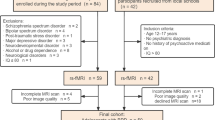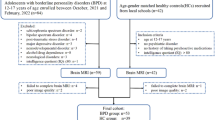Abstract
Borderline personality disorder (BPD) is characterized by interpersonal disturbances and dysfunctional behavior such as non-suicidal self-injury (NSSI). We recently observed neural alterations in BPD during social inclusion by enhanced activations within the dorsomedial prefrontal cortex (dmPFC) and the posterior cingulate cortex (PCC). To examine the specificity of these neural alterations, we now investigated participants with NSSI but without BPD and compared them to BPD and healthy controls (HC). Considering the association between NSSI and BPD, we further examined neural commonalities during social inclusion. Fifteen females diagnosed with BPD, 16 with NSSI and 17 HC were investigated by fMRI and the cyberball paradigm, focusing on social inclusion (p < 0.05; FWE on cluster-level). To examine neural commonalities between BPD and NSSI compared to HC, we computed a conjunction analysis on neural activations under social inclusion. Significant increases in neural activation were observed in BPD within the dmPFC under social inclusion compared to NSSI and HC, whereas neural activations within the PCC did not differ between BPD and NSSI. The conjunction analysis revealed a common neurofunctional increase within the pregenual anterior cingulate cortex and the anterior insula in both, BPD and NSSI. We provide a further evidence regarding a disorder-specific neural reactivity within the dmPFC during social inclusion in BPD, whereas PCC activations may represent an unspecific neural alteration in BPD when compared to NSSI. In contrast, both clinical groups revealed a common neural increase within the salience network that may support the assumptions of a developmental continuum between these two psychiatric conditions.

Similar content being viewed by others
References
American Psychiatric Association (2013) Diagnostic and statistical manual of mental disorders, 5th ediion (DSM-5). Diagnostic Stat. Man. Ment. Disord. 4th edn. TR., 280. https://doi.org/10.1176/appi.books.9780890425596.744053
Amodio DM, Frith CD (2006) Meeting of minds: the medial frontal cortex and social cognition. Nat Rev Neurosci. https://doi.org/10.1038/nrn1884
Andover MS, Morris BW (2014) Expanding and clarifying the role of emotion regulation in nonsuicidal self-injury. Can J Psychiatry. https://doi.org/10.1177/070674371405901102
Atique B, Erb M, Gharabaghi A, Grodd W, Anders S (2011) Task-specific activity and connectivity within the mentalizing network during emotion and intention mentalizing. Neuroimage. https://doi.org/10.1016/j.neuroimage.2010.12.036
Baer RA, Peters JR, Eisenlohr-Moul TA, Geiger PJ, Sauer SE (2012) Emotion-related cognitive processes in borderline personality disorder: a review of the empirical literature. Clin Psychol Rev. https://doi.org/10.1016/j.cpr.2012.03.002
Bohus M, Limberger MF, Frank U, Chapman AL, Kuhler T, Stieglitz RD (2007) Psychometric properties of the Borderline Symptom List (BSL). Psychopathology 40:126–132. https://doi.org/10.1159/000098493
Bonenberger M, Plener PL, Groschwitz RC, Grön G, Abler B (2015) Differential neural processing of unpleasant haptic sensations in somatic and affective partitions of the insula in non-suicidal self-injury (NSSI). Psychiatry Res Neuroimaging 234:298–304. https://doi.org/10.1016/j.pscychresns.2015.10.013
Brewer JA, Garrison KA, Whitfield-Gabrieli S (2013) What about the “self” is processed in the posterior cingulate cortex? Front Hum Neurosci. https://doi.org/10.3389/fnhum.2013.00647
Brown RC, Plener PL, Groen G, Neff D, Bonenberger M, Abler B (2017) Differential neural processing of social exclusion and inclusion in adolescents with non-suicidal self-injury and young adults with borderline personality disorder. Front Psychiatry. https://doi.org/10.3389/fpsyt.2017.00267
Bungert M, Liebke L, Thome J, Haeussler K, Bohus M, Lis S (2015) Rejection sensitivity and symptom severity in patients with borderline personality disorder: effects of childhood maltreatment and self-esteem. Borderline Personal Disord Emot Dysregul. https://doi.org/10.1186/s40479-015-0025-x
Corradi-Dell’Acqua C, Hofstetter C, Vuilleumier P (2014) Cognitive and affective theory of mind share the same local patterns of activity in posterior temporal but not medial prefrontal cortex. Soc Cogn Affect Neurosci. https://doi.org/10.1093/scan/nst097
Distel MA, Smit JH, Spinhoven P, Penninx BWJH (2016) Borderline personality features in depressed or anxious patients. Psychiatry Res. https://doi.org/10.1016/j.psychres.2016.05.007
Domsalla M, Koppe G, Niedtfeld I, Vollstädt-Klein S, Schmahl C, Bohus M et al (2014) Cerebral processing of social rejection in patients with borderline personality disorder. Soc Cogn Affect Neurosci 9:1789–1797. https://doi.org/10.1093/scan/nst176
Eisenberger NI (2012) The pain of social disconnection: examining the shared neural underpinnings of physical and social pain. Nat Rev Neurosci. https://doi.org/10.1038/nrn3231
Eisenberger NI, Lieberman MD, Williams KD (2003) Does rejection hurt? An FMRI study of social exclusion. Science (80-.) 302:290–292. https://doi.org/10.1126/science.1089134
Eisenberger NI, Taylor SE, Gable SL, Hilmert CJ, Lieberman MD (2007) Neural pathways link social support to attenuated neuroendocrine stress responses. Neuroimage 35:1601–1612. https://doi.org/10.1016/j.neuroimage.2007.01.038
Etkin A, Egner T, Kalisch R (2011) Emotional processing in anterior cingulate and medial prefrontal cortex. Trends Cogn Sci. https://doi.org/10.1016/j.tics.2010.11.004
First MB, Spitzer RL, Gibbon M, Williams JBW (1997) User’s guide for the structured clinical interview for DSM-IV axis I disorders SCID-I: clinician version. American Psychiatric Publication, Washington
Fischer G, Ameis N, Parzer P, Plener PL, Groschwitz R, Vonderlin E et al (2014) The German version of the self-injurious thoughts and behaviors interview (SITBI-G): a tool to assess non-suicidal self-injury and suicidal behavior disorder. BMC Psychiatry 14:265. https://doi.org/10.1186/s12888-014-0265-0
Franzen N, Hagenhoff M, Baer N, Schmidt A, Mier D, Sammer G et al (2011) Superior “theory of mind” in borderline personality disorder: An analysis of interaction behavior in a virtual trust game. Psychiatry Res. https://doi.org/10.1016/j.psychres.2010.11.012
Frías Á, Palma C (2015) Comorbidity between post-traumatic stress disorder and borderline personality disorder: a review. Psychopathology. https://doi.org/10.1159/000363145
Groschwitz RC, Kaess M, Fischer G, Ameis N, Schulze UME, Brunner R et al (2015) The association of non-suicidal self-injury and suicidal behavior according to DSM-5 in adolescent psychiatric inpatients. Psychiatry Res. https://doi.org/10.1016/j.psychres.2015.06.019
Hautzinger M, Keller F, Kühner C (2006) Beck depressions-inventar (BDI-II). Harcourt Test Services, Frankfurt
Jamieson JP, Harkins SG, Williams KD (2010) Need threat can motivate performance after ostracism. Pers Soc Psychol Bull 36:690–702. https://doi.org/10.1177/0146167209358882
Kawamoto T, Onoda K, Nakashima K, Nittono H, Yamaguchi S, Ura M (2012) Is dorsal anterior cingulate cortex activation in response to social exclusion due to expectancy violation? An fMRI study. Front Evol Neurosci. https://doi.org/10.3389/fnevo.2012.00011
Leary MR, Springer C (2001) Hurt feelings: the neglected emotion. In: Kowalski RM (ed) Aversive behaviors and relational transgressions. American Psychological Association, Washington, DC
Lis S, Bohus M (2013) Social interaction in borderline personality disorder. Curr Psychiatry Rep. https://doi.org/10.1007/s11920-012-0338-z
Malejko K, Neff D, Brown R, Plener PL, Bonenberger M, Abler B et al (2018) Neural correlates of social inclusion in borderline personality disorder. Front Psychiatry 9:653. https://doi.org/10.3389/fpsyt.2018.00653
Menon V, Uddin LQ (2010) Saliency, switching, attention and control: a network model of insula function. Brain Struct Funct. https://doi.org/10.1007/s00429-010-0262-0
Mitchell JP (2008) Contributions of functional neuroimaging to the study of social cognition. Curr Dir Psychol Sci. https://doi.org/10.1111/j.1467-8721.2008.00564.x
Ochsner KN, Knierim K, Ludlow DH, Hanelin J, Ramachandran T, Glover G et al (2004) Reflecting upon feelings: an fMRI study of neural systems supporting the attribution of emotion to self and other. J Cogn Neurosci. https://doi.org/10.1162/0898929042947829
Perini I, Gustafsson PA, Hamilton JP, Kämpe R, Zetterqvist M, Heilig M (2018) The salience of self, not social pain, is encoded by dorsal anterior cingulate and insula. Sci Rep. https://doi.org/10.1038/s41598-018-24658-8
Powers KE, Wagner DD, Norris CJ, Heatherton TF (2013) Socially excluded individuals fail to recruit medial prefrontal cortex for negative social scenes. Soc Cogn Affect Neurosci 8:151–157. https://doi.org/10.1093/scan/nsr079
Renneberg B, Herm K, Hahn A, Staebler K, Lammers C-H, Roepke S (2012) Perception of social participation in borderline personality disorder. Clin Psychol Psychother. https://doi.org/10.1002/cpp.772
Ruocco AC, Medaglia JD, Tinker JR, Ayaz H, Forman EM, Newman CF et al (2010) Medial prefrontal cortex hyperactivation during social exclusion in borderline personality disorder. Psychiatry Res Neuroimaging. https://doi.org/10.1016/j.pscychresns.2009.12.001
Sebastian CL, Tan GCY, Roiser JP, Viding E, Dumontheil I, Blakemore SJ (2011) Developmental influences on the neural bases of responses to social rejection: implications of social neuroscience for education. Neuroimage. https://doi.org/10.1016/j.neuroimage.2010.09.063
Somerville LH, Heatherton TF, Kelley WM (2006) Anterior cingulate cortex responds differentially to expectancy violation and social rejection. Nat Neurosci. https://doi.org/10.1038/nn1728
Staebler K, Helbing E, Rosenbach C, Renneberg B (2011) Rejection sensitivity and borderline personality disorder. Clin Psychol Psychother 18:275–283. https://doi.org/10.1002/cpp.705
Williams KD, Cheung CK, Choi W (2000) Cyberostracism: effects of being ignored over the Internet. J Pers Soc Psychol 79:748–762
Zetterqvist M (2015) The DSM-5 diagnosis of nonsuicidal self-injury disorder: a review of the empirical literature. Child Adolesc Psychiatry Ment Health. https://doi.org/10.1186/s13034-015-0062-7
Author information
Authors and Affiliations
Corresponding author
Ethics declarations
Conflicts of interest
Paul L. Plener was an investigator in clinical studies by Servier and Lundbeck phamaceuticals. He received a speaker’s honorarium by Shire. He received research funding from the German Federeal Ministry of Education and Research, the German Federal Institute for Drugs and Medical Devices, the Baden-Wuerttemberg as well as the Volkswagen Foundation. Kathrin Malejko, Dominik Neff, Rebecca Brown, Martina Bonenberger, Birgit Abler and Heiko Graf declare that they have no conflicts of interest.
Ethical Approval
All procedures performed in this study were in accordance with the ethical standards of the institutional and/or national research committee and with the 1964 Helsinki declaration and its later amendments or comparable ethical standards.
Informed Consent
A written informed consent was obtained from all individual participants included in the study.
Additional information
Handling Editor: Stefano Seri
Publisher's Note
Springer Nature remains neutral with regard to jurisdictional claims in published maps and institutional affiliations.
Electronic supplementary material
Below is the link to the electronic supplementary material.
Rights and permissions
About this article
Cite this article
Malejko, K., Neff, D., Brown, R.C. et al. Neural Signatures of Social Inclusion in Borderline Personality Disorder Versus Non-suicidal Self-injury. Brain Topogr 32, 753–761 (2019). https://doi.org/10.1007/s10548-019-00712-0
Received:
Accepted:
Published:
Issue Date:
DOI: https://doi.org/10.1007/s10548-019-00712-0




